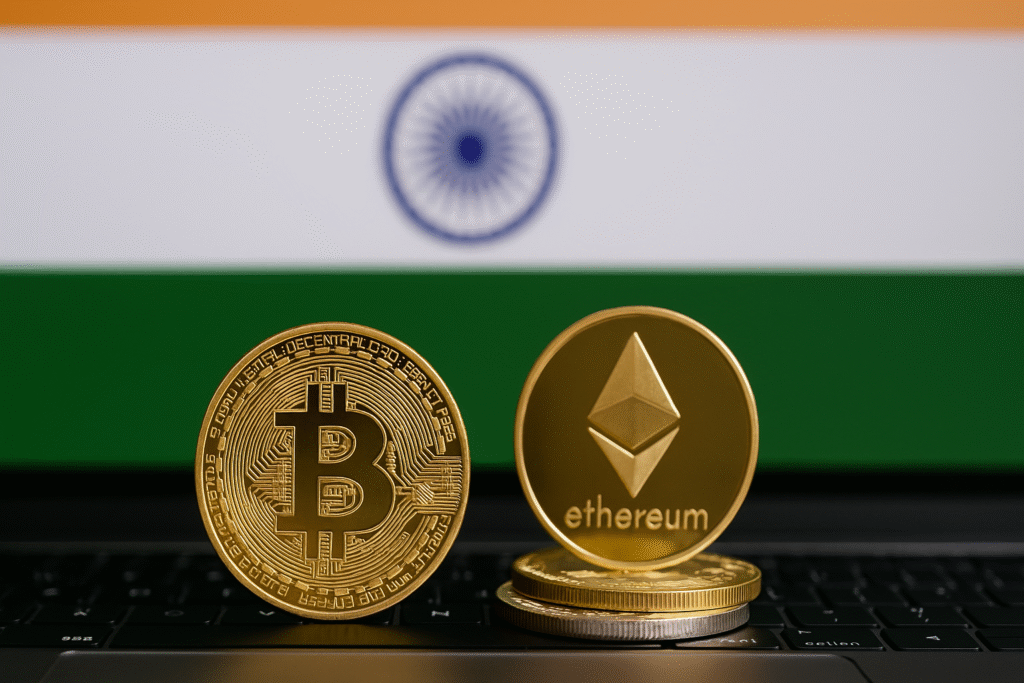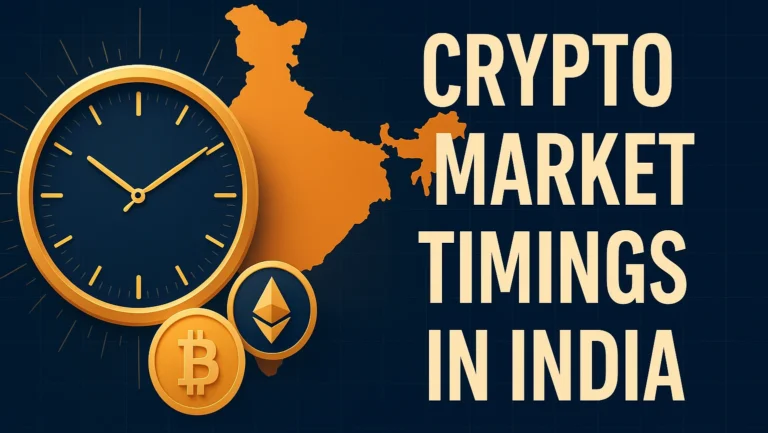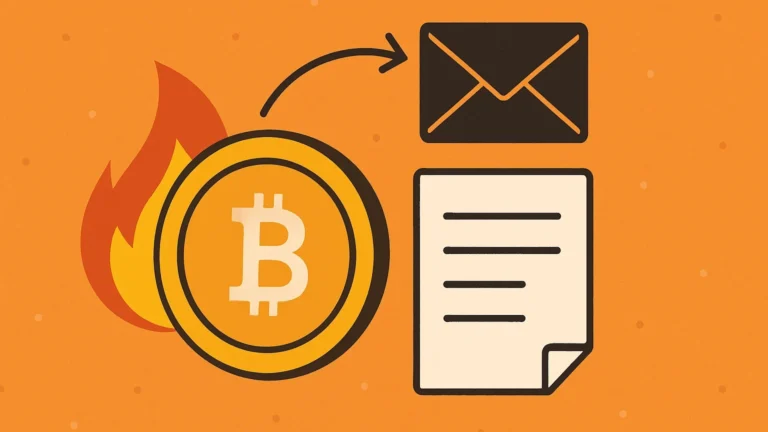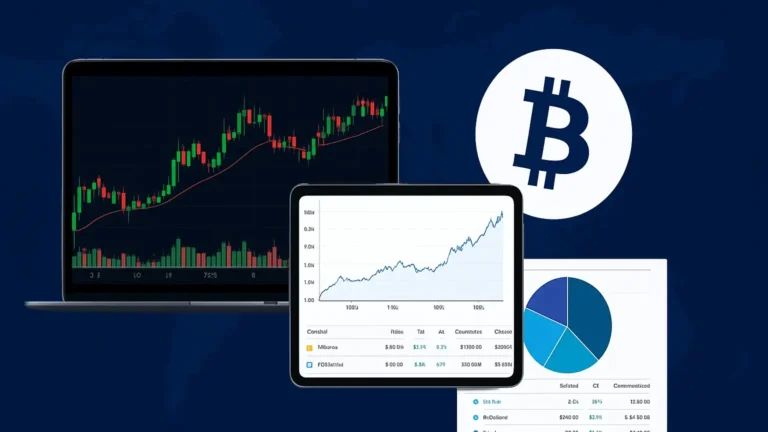Where to Buy Crypto in India: Legal, Safe

Where to Buy Crypto in India
Curious about where to buy crypto in India safely and legally? This guide explores the top FIU-registered cryptocurrency exchanges in India, including their features, safety measures, and how to get started.
Whether you’re a beginner or an experienced investor, learn everything you need to know before making your first crypto purchase.
Buying cryptocurrency in India has become much easier in recent years. Here are some of the most popular and trusted platforms where you can buy Bitcoin, Ethereum, and other cryptocurrencies:
Top Crypto Exchanges in India:
- WazirX
- One of India’s most popular crypto exchanges
- Supports UPI and bank transfers
- Offers its own token (WRX)
- Linked with Binance for easy transfers
- CoinDCX
- Over 200+ cryptocurrencies available
- Quick KYC and user-friendly interface
- Offers educational resources via DCX Learn
- ZebPay
- One of the oldest crypto platforms in India
- Known for secure wallets and low trading fees
- Advanced trading tools for experienced users
- Binance
- World’s largest crypto exchange by volume
- Allows INR deposits via P2P and integration with WazirX
- Offers advanced trading and staking options
- CoinSwitch Kuber
- Best for beginners
- Start investing with as little as ₹100
- Simple interface with zero trading fees (T&C apply)
Things to Keep in Mind While Buying Crypto:
- Always complete KYC (You will need Aadhaar & PAN card)
- Use strong passwords and enable 2FA (Two-Factor Authentication)
- Use only trusted platforms and verified payment channels
- Do your own research (DYOR) before investing long-term
Payment Methods Available:
- UPI (Google Pay, PhonePe, Paytm, etc.)
- IMPS / NEFT / RTGS bank transfers
- P2P (Peer-to-Peer) trading for direct user transactions
Step-by-Step Guide to Buy Crypto on WazirX (India)
Step 1: Download the WazirX App or Visit Website
- Go to: https://wazirx.com
- Or download the WazirX app from the Play Store (Android) or App Store (iOS)
Step 2: Sign Up
- Click on “Sign Up”
- Enter your email address and create a strong password
- Accept terms and click “Sign Up”
Step 3: Verify Your Email
- WazirX will send a verification link to your email
- Open the email and click on the verification link
Step 4: Enable 2FA (Two-Factor Authentication)
- Use Google Authenticator or your phone number to secure your account
- Strongly recommended for safety
Step 5: Complete KYC (Know Your Customer)
- Submit the following:
- PAN card
- Aadhaar card or any other ID proof
- Selfie for verification
- KYC approval usually takes a few hours to a day
Step 6: Add Funds to Your Account
You can add INR (Indian Rupees) using:
- UPI
- Bank Transfer (IMPS/NEFT/RTGS)
Go to Funds – INR – Deposit – Choose Payment Method
Step 7: Buy Your First Crypto
- Once your deposit is complete, go to the “Exchange” tab
- Choose the crypto you want to buy (e.g., BTC/INR for Bitcoin)
- Enter the amount you want to buy
- Click Buy
Done! You now own cryptocurrency.
Tips for Beginners:
- Start small– invest only what you can afford to lose
- Store your crypto in a secure wallet (can be on the app or in a hardware wallet for large amounts)
- Keep learning – follow crypto news and trends
Step-by-Step Guide to Buy Crypto on CoinDCX (India)
Step 1: Download the CoinDCX App or Visit Website
- Website: https://coindcx.com
- Or download the CoinDCX app from Play Store (Android) or App Store (iOS)
Step 2: Sign Up
- Tap on “Sign Up”
- Enter your email, mobile number, and password
- Verify using OTP sent to your phone
Step 3: Complete KYC
To unlock full features, complete KYC:
- Upload your PAN card
- Upload Aadhaar or any government ID
- Take a selfie for verification
- Usually verified in a few hours
Step 4: Add INR Funds
- Go to “Add Funds”
- Choose UPI, IMPS, or Bank Transfer
- Enter the amount you want to deposit
- Complete payment
Funds are added almost instantly via UPI
Step 5: Buy Crypto
- Go to the “Buy” section
- Select your desired crypto (e.g. BTC, ETH, SHIB, etc.)
- Enter amount in INR (you can start with as little as ₹100)
- Tap “Buy”
Your crypto will be added to your CoinDCX wallet
Extra Tips:
- You can use DCX Learn (on their site) for beginner crypto courses
- Check “Price Alerts” to get notified about market dips
- Enable 2FA from settings for better account security
Step-by-Step Guide to Buy Crypto on Binance
Step 1: Go to Binance
- Website: https://binance.com
- Or download Binance app (Android/iOS)
Step 2: Create an Account
- Enter email and password
- Verify using OTP
- Set up 2FA (Google Authenticator or SMS)
Step 3: Complete KYC
- Submit ID proof (Aadhaar or passport + PAN)
- Usually approved within a few hours
Step 4: Go to P2P Section
- Tap on “P2P Trading”
- Choose “Buy USDT” (USDT is a stablecoin tied to USD value)
- Filter payment method to UPI or Bank Transfer
Step 5: Choose a Seller & Make Payment
- Select a seller with high rating and enough volume
- Enter amount (e.g., ₹500 or ₹1000)
- Binance will show seller’s UPI ID
- Transfer payment and click “Payment Done”
Step 6: Get Your Crypto
- Seller confirms payment
- Binance automatically releases USDT to your wallet
You can now:
- Use USDT to trade BTC, ETH, etc. on Binance
- Or transfer to other wallets and exchanges
Legalization for crypto in india
Is Cryptocurrency Legal in India?
- Yes, it is legal to buy, sell, and hold cryptocurrencies in India like Bitcoin, Ethereum, etc.
- However, it is not considered legal tender (i.e., you can not use crypto to pay for goods and services like you can with INR).
Regulatory Framework
- No Ban
- There is no blanket ban on crypto in India.
- In 2020, the Supreme Court struck down the RBI ban on crypto trading.
- Regulation Under FEMA & PMLA
- In March 2023, the Prevention of Money Laundering Act (PMLA) was extended to include crypto transactions.
- This means KYC (Know Your Customer) and reporting are mandatory for crypto exchanges.
- Self-Regulation by Exchanges
- Major Indian exchanges like CoinDCX, WazirX, and CoinSwitch Kuber follow compliance norms.
- They are expected to register with FIU-IND (Financial Intelligence Unit of India).
Tax Rules on Crypto (as of FY 2025-26)
- 30% Flat Tax
- Any income from the sale of crypto is taxed at 30%, regardless of your income bracket.
- 1% TDS (Tax Deducted at Source)
- A 1% TDS is deducted on crypto transactions over a certain threshold (₹10,000 per transaction or ₹50,000 annually).
- No Deduction Allowed
- No deductions allowed except for the cost of acquisition.
- Losses from crypto cannot be offset against other income.
RBI & CBDC Perspective
- RBI still expresses concerns over crypto, mainly around volatility and risk.
- India is pushing forward with its own Central Bank Digital Currency (CBDC) – the Digital Rupee, which is regulated and backed by RBI.
What You Should NOT Do
- Do not use foreign unregistered exchanges (like Binance, Kraken) without checking if they are FIU-compliant.
- Do not trade anonymously or avoid KYC – this may lead to PMLA-related consequences.
- Avoid using crypto for any illegal or untraceable payments.
What You CAN Do Legally
- Buy/sell crypto via registered Indian exchanges.
- Hold crypto assets in your personal wallet.
- Pay taxes on any profit from trading crypto.
Step-by-Step: How to Report Crypto Income in India
Step 1: Classify Your Crypto Income
Under Indian law, all gains from Virtual Digital Assets (VDAs) like Bitcoin, Ethereum, NFTs, etc., are taxed as:
“Income from Transfer of Virtual Digital Assets” under Section 115BBH of the Income Tax Act.
This includes:
- Selling crypto for INR
- Swapping one crypto for another
- Using crypto to pay for goods/services
Step 2: Calculate Your Taxable Gain
Formula:
javaCopyEditTaxable Gain = Selling Price – Cost of Acquisition
No other deductions allowed (like internet fees, mining costs, etc.)
Step 3: Apply the 30% Tax Rate
- Flat 30% tax on profits from crypto transactions.
- Surcharge + 4% health & education cess applies as per your income bracket.
Step 4: Deduct TDS (if applicable)
- 1% TDS (u/s 194S) is deducted at the time of crypto sale if the annual transaction exceeds:
- ₹10,000 for most individuals
- ₹50,000 for those not in business
You can claim this TDS while filing your ITR.
Step 5: Choose the Right ITR Form
- ITR-2 – For salaried individuals with capital gains (use this if crypto is not your business).
- ITR-3 – For individuals earning income from business/profession (if crypto trading is regular business).
- ITR-4 – Cannot be used for crypto income.
Step 6: File the Income in the VDA Section
In the ITR form (e.g., ITR-2), go to:
Schedule VDA – Enter:
- Type of asset (e.g., BTC, ETH)
- Date of acquisition and sale
- Buy price and sell price
- Gain
- TDS deducted
Step 7: Pay Advance Tax (if applicable)
- If your crypto profits exceed ₹10,000 tax liability, you must pay advance tax in four installments (June, Sept, Dec, March).
- Failure to pay advance tax may lead to penalty interest under Section 234B and 234C.
Example:
You sold 1 BTC for ₹40 lakhs.
You bought it for ₹20 lakhs.
You earned ₹20 lakhs profit.
You pay:
- ₹6 lakhs (30%) as income tax
- + Cess/Surcharge as applicable
If 1% TDS = ₹40,000 was already deducted, you claim that while filing ITR.
Deadlines:
- Advance Tax: Quarterly, if applicable
- ITR Filing Deadline (FY 2024–25): 31st July 2025 (for individuals not subject to audit)
Safety and Precautions While Investing in Crypto
1. Use Only Trusted Platforms
- Choose FIU-registered exchanges in India (like CoinDCX, CoinSwitch, or ZebPay).
- Avoid using unregulated or foreign platforms without proper compliance.
2. Always Complete KYC
- Use your real identity.
- Avoid anonymous trading – it’s risky and may violate the PMLA (Prevention of Money Laundering Act).
3. Enable 2FA (Two-Factor Authentication)
- Add an extra layer of security using Google Authenticator or Authy.
- Never share your OTPs or private codes.
4. Use a Cold Wallet for Large Funds
- Keep your major holdings in cold wallets (offline storage) like Ledger or Trezor.
- Use hot wallets (apps) only for small, everyday trading amounts.
5. Do Your Own Research
- Don’t invest based on YouTube hype, Telegram tips, or Twitter trends.
- Study the project’s fundamentals, whitepaper, and team before investing.
6. Beware of Scams and Phishing
- Avoid clicking on unknown crypto links, fake airdrops, or giveaways.
- Double-check website URLs (e.g., “binance.com” vs fake ones).
7. Never Invest Money You Can’t Afford to Lose
- Crypto is highly volatile – prices can swing 20–50% in a day.
- Only allocate a small portion of your portfolio to crypto.
8. Follow Indian Tax & Legal Rules
- Report all profits in your ITR (Income Tax Return).
- Pay 30% tax on profits and track 1% TDS on trades.
- Use exchanges that provide TDS certificates and transaction reports.
9. Keep Records of All Transactions
- Maintain a log of:
- Buy/sell dates and prices
- Wallet addresses
- TDS deducted
- This helps during tax filing or audits.
- Your private key = your money.
- Store it offline, never in email or cloud drives.
Conclusion
I hope you must liked our complete learning on where to buy crypto in india.
Buying cryptocurrency in India is now more accessible and regulated than ever before. With several trusted and FIU-registered platforms like CoinDCX, WazirX, and CoinSwitch offering secure and user-friendly interfaces, investors have a range of options to begin their crypto journey.
However, it is crucial to prioritize safety, complete KYC, understand tax obligations, and stay updated with regulatory changes. By choosing the right exchange and following proper precautions, you can confidently and legally participate in India’s growing crypto ecosystem.
Contents
- 1 Where to Buy Crypto in India
- 2 Top Crypto Exchanges in India:
- 3 Things to Keep in Mind While Buying Crypto:
- 4 Step-by-Step Guide to Buy Crypto on WazirX (India)
- 5 Tips for Beginners:
- 6 Step-by-Step Guide to Buy Crypto on CoinDCX (India)
- 7 Step-by-Step Guide to Buy Crypto on Binance
- 8 Legalization for crypto in india
- 9 Step-by-Step: How to Report Crypto Income in India
- 10 Example:
- 11 Deadlines:
- 12 Safety and Precautions While Investing in Crypto
- 12.1 1. Use Only Trusted Platforms
- 12.2 2. Always Complete KYC
- 12.3 3. Enable 2FA (Two-Factor Authentication)
- 12.4 4. Use a Cold Wallet for Large Funds
- 12.5 5. Do Your Own Research
- 12.6 6. Beware of Scams and Phishing
- 12.7 7. Never Invest Money You Can’t Afford to Lose
- 12.8 8. Follow Indian Tax & Legal Rules
- 12.9 9. Keep Records of All Transactions
- 12.10 10. Don’t Share Wallet Keys or Seed Phrases
- 13 Conclusion







i face problem in coindcx cyc.
Contact with coindcx support team.